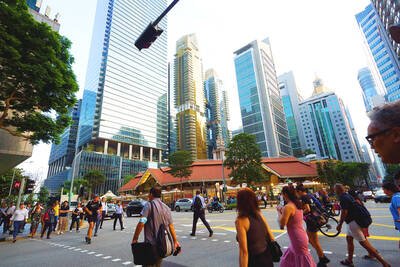Australia’s central bank chief highlighted worries among households and businesses about the health and economic outlook, as the nation’s successful run of COVID-19 containment was rocked by a new outbreak, damping the economy’s otherwise improving prospects.
Reserve Bank of Australia (RBA) Governor Philip Lowe kept the cash rate and three-year yield target unchanged at 0.25 percent, as expected.
Soaring job advertisements and retail sales suggest that the economy is recovering, yet a spiraling rate of novel coronavirus cases in Australia’s second-largest city is a stark reminder of ongoing risks.
“The downturn has been less severe than earlier expected” and conditions have stabilized recently, Lowe said in a statement after the policy meeting.
However, “uncertainty about the health situation and the future strength of the economy is making many households and businesses cautious, and this is affecting consumption and investment plans,” he said.
The central bank is leaning on fiscal authorities to keep injecting stimulus into the economy to help make up for the retreat in private activity. Australian Prime Minister Scott Morrison’s government plans to deliver an economic statement on July 23 that would outline ongoing support and where it intends to let programs expire.
New South Wales and Victoria, the nation’s most populous and economically powerful states, are to close their border tonight as Victoria authorities battle to contain Melbourne’s worst spike in novel coronavirus cases since the crisis began.
The state government announced shortly after the RBA’s decision that it is locking down the Melbourne metropolitan area for six weeks.
The Australian dollar slipped on the Victoria announcement, trading at US$0.6956 at 3:45pm in Sydney.
While Australia has been one of the standout performers globally in limiting the spread of the virus to about 9,000 cases, Victoria’s flare-up shows just how hard it is to eradicate without a vaccine, as Lowe himself said.
Australia’s economy lost more than 800,000 jobs in April and May and the unemployment rate hit 7.1 percent, with the Australian Treasury expecting it to reach 8 percent this quarter.
The government’s JobKeeper program, which pays a wage subsidy to keep workers attached to firms, has been instrumental in containing the jobless rate. The program is due to expire in September and its fate will likely be closely watched in the Morrison government’s statement this month.
“The substantial, coordinated and unprecedented easing of fiscal and monetary policy in Australia is helping the economy through this difficult period,” Lowe said. “It is likely that fiscal and monetary support will be required for some time.”
“The board will not increase the cash rate target until progress is being made towards full employment and it is confident that inflation will be sustainably within the 2 to 3 percent target band,” he said, reiterating the bank’s stance.
When questioned on the currency last month, Lowe said it is hard to argue that the exchange rate is overvalued given the relative health and economic struggles of some other countries.
The governor was a little more upbeat about the global backdrop.
“Leading indicators have generally picked up recently, suggesting the worst of the global economic contraction has now passed,” he said. “Despite this, the outlook remains uncertain and the recovery is expected to be bumpy, and will depend upon containment of the coronavirus.”

Among the rows of vibrators, rubber torsos and leather harnesses at a Chinese sex toys exhibition in Shanghai this weekend, the beginnings of an artificial intelligence (AI)-driven shift in the industry quietly pulsed. China manufactures about 70 percent of the world’s sex toys, most of it the “hardware” on display at the fair — whether that be technicolor tentacled dildos or hyper-realistic personalized silicone dolls. Yet smart toys have been rising in popularity for some time. Many major European and US brands already offer tech-enhanced products that can enable long-distance love, monitor well-being and even bring people one step closer to

Malaysia’s leader yesterday announced plans to build a massive semiconductor design park, aiming to boost the Southeast Asian nation’s role in the global chip industry. A prominent player in the semiconductor industry for decades, Malaysia accounts for an estimated 13 percent of global back-end manufacturing, according to German tech giant Bosch. Now it wants to go beyond production and emerge as a chip design powerhouse too, Malaysian Prime Minister Anwar Ibrahim said. “I am pleased to announce the largest IC (integrated circuit) Design Park in Southeast Asia, that will house world-class anchor tenants and collaborate with global companies such as Arm [Holdings PLC],”

Thousands of parents in Singapore are furious after a Cordlife Group Ltd (康盛人生集團), a major operator of cord blood banks in Asia, irreparably damaged their children’s samples through improper handling, with some now pursuing legal action. The ongoing case, one of the worst to hit the largely untested industry, has renewed concerns over companies marketing themselves to anxious parents with mostly unproven assurances. This has implications across the region, given Cordlife’s operations in Hong Kong, Macau, Indonesia, the Philippines and India. The parents paid for years to have their infants’ cord blood stored, with the understanding that the stem cells they contained

Sales in the retail, and food and beverage sectors last month continued to rise, increasing 0.7 percent and 13.6 percent respectively from a year earlier, setting record highs for the month of March, the Ministry of Economic Affairs said yesterday. Sales in the wholesale sector also grew last month by 4.6 annually, mainly due to the business opportunities for emerging applications related to artificial intelligence (AI) and high-performance computing technologies, the ministry said in a report. The ministry forecast that retail, and food and beverage sales this month would retain their growth momentum as the former would benefit from Tomb Sweeping Day